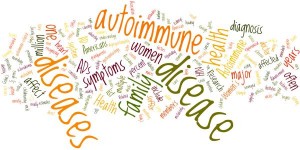 What does Celiac Disease have in common with Multiple Sclerosis? Or, Lupus with Hashimoto’s? How about Rheumatoid Arthritis with Grave’s disease?
What does Celiac Disease have in common with Multiple Sclerosis? Or, Lupus with Hashimoto’s? How about Rheumatoid Arthritis with Grave’s disease?
Well, it may surprise you to know that all of these, plus more than a hundred others*, are all related. They are all autoimmune diseases at the root, and, more shockingly, more than 23 million Americans are suffering from one or more of these chronic, sometimes fatal, conditions.
Some people may not even know they have an autoimmune disease because their conventional doctors have not been able to correctly diagnose the disorder, oftentimes prescribing medications to treat the symptoms, rather than getting to the root of the illness. As a result, many people needlessly live in pain or discomfort simply because they don’t know there are other options out there.
So, what is an autoimmune disease? Very briefly, it is when the immune system, which produces antibodies to defend the body from foreign invaders like infections, germs, etc., is not working properly and ends up attacking its own healthy cells. For detailed information, refer back to my previous blog.
Today we’ll look at a few of the more common autoimmune diseases we see every day in our practice and the symptoms associated with each one. They are: Celiac – Grave’s – Hashimoto’s – Lupus – Multiple Sclerosis (MS) – Rheumatoid Arthritis (RA) – Sjögren’s Syndrome.
Celiac Disease is caused by an allergy to gluten, the protein found in wheat, barley, rye, spelt, and kamut. The villi (finger-like protrusions), that line and protect the small intestines are destroyed because the body sees the gluten as the enemy and starts to attack, but it is mistakenly attacking and destroying itself.
- Symptoms of Celiac can be wide-ranging since symptoms can sometimes manifest in other areas of the body. Even if results for celiac disease are negative, you may still have sensitivity to gluten, otherwise known as gluten intolerance. Staying away from gluten or foods cross-contaminated with gluten is the answer to feeling well. Some common symptoms include: arthritis – brain fog – fatigue – diarrhea – gas – bloating – anemia
- Detailed information on Celiac Disease and what tests to request from your health care professional can be found in my new book: The Immune System Recovery Plan.
Grave’s Disease, named after Dr. Robert Graves 150 years ago, symptoms are caused by the over-production of the hormone thyroxine in the thyroid gland, also called hyperthyroidism.
- Symptoms of Grave’s Disease include: weight loss – rapid pulse – protruding eyes – insomnia – feeling too warm – restlessness – diarrhea – irritability – heart palpitations
- Detailed information on Grave’s Disease and what tests to request from your health care professional can be found in my new book: The Immune System Recovery Plan.
Hashimoto’s Thyroiditis, named after Dr. Hakaru Hashimoto over 100 years ago, is when the immune cells turn against the thyroid gland, attacking and irritating it, causing the gland to produce too little thyroid hormone, also called hypothyroidism, the complete opposite of hyperthyroidism (too much hormone production) as in Grave’s. The early stages of Hashimoto’s can be easily missed because the thyroid is able to function pretty well. However, if the immune attack goes undetected for too long, the thyroid can become permanently damaged, which will mean permanent hormone replacement medication. So, early detection and testing are key to reversing this disease.
- Symptoms of Hashimoto’s include: enlarged thyroid (goiter) – sore throat, if your thyroid is actively inflamed – fatigue – hair loss – weight gain
- Detailed information on Hashimoto’s Thyroiditis Disease and what tests to request from your health care professional can be found in my new book: The Immune System Recovery Plan.
Lupus, or Systemic Lupus Erythematosus (SLE), is different than the other autoimmune diseases in that the immune system attacks the DNA of every cell, making the effects widespread throughout the body. It not only affects the central nervous system, like MS, but also several organs, such as the skin, joints, kidneys, and nervous system, but it can damage any other organ as well. The disease is nine times more common in women than in men, especially those in their 20’s & 30’s.
- Symptoms of Lupus include:fatigue – muscle pain and weakness – fever when disease is active – symptoms specific to the organ involved, like joint/muscle pain; difficulty breathing – butterfly rash over the cheeks and nose, appearing after sun exposure – hair loss, but not baldness – painless oral or nasal ulcers – color changes of the fingers or feet brought on by cold or emotion
- Detailed information on Lupus and what tests to request from your health care professional can be found in my new book: The Immune System Recovery Plan.
Multiple Sclerosis(MS) affects the brain and the spinal cord, or central nervous system. When the myelin, which is the protective coating of all the nerves in your body, is damaged by the autoimmune attack, it gets damage and people experience symptoms. Largely, MS affects northern European women of child-bearing age. The most common first symptom is a central nervous system dysfunction as optic neuritis, or eye pain, that gets worse when your move your eye in any direction.
- Symptoms of Multiple Sclerosis (MS) include:eye pain – numbness, tingling, or pins-and-needles anywhere in the body, that does not go away after two weeks – swelling of the limbs or trunk – intense itching, especially in the neck area
- Detailed information on Multiple Sclerosis (MS) and what tests to request from your health care professional can be found in my new book: The Immune System Recovery Plan.
Rheumatoid Arthritis(RA) occurs when your immune cells attack your joints, causing tissue damage, inflammation, and pain in your wrists, fingers, knees, feet, ankles, and surrounding tissue. RA is a very specific form of arthritis, and it may be difficult to tell the difference between the symptoms of RA and common osteoarthritis pain that can occur with aging, or after an injury. Specific blood testing is sometimes the only way to know which kind of arthritis you have.
- Symptoms of Rheumatoid Arthritis (RA) include:muscle pain – fatigue – low-grade fever – weight loss – depression – morning stiffness lasting at least one hour for at least six weeks – swelling of three or more joints for at least six weeks – swelling of wrist or fingers for at least six weeks – joint swelling on both sides of the body (symmetric) – nodules or bumps under the skin and affected joint
- Detailed information on Rheumatoid Arthritis (RA) and what tests to request from your health care professional can be found in my new book: The Immune System Recovery Plan.
Sjögren’s Syndrome is an attack on the moisture-producing glands, which include the salivary glands in the mouth, and the lacrimal glands in the eyes that produce tears. Sjögren’s Syndrome can occur on its own or in conjunction with RA. 90% of patients are female.
- Symptoms of Sjögren’s Syndrome include:dry mouth and eyes – dryness in the vagina, skin, lungs, sinuses, and digestive tract – fatigue – joint pain – muscle pain – cognitive dysfunction
- Detailed information on Sjögren’s Syndrome and what tests to request from your health care professional can be found in my new book: The Immune System Recovery Plan.
Being diagnosed with an autoimmune disease is serious, and should be treated as such, but it does not have to be a life sentence! You can heal your immune system and free yourself of a lifetime of taking meds. While we know this is a lot of information, don’t worry, the book takes you very slowly through this process…we are here to help you!
* For a complete list of autoimmune diseases: https://www.aarda.org/research_display.php?ID=47.
